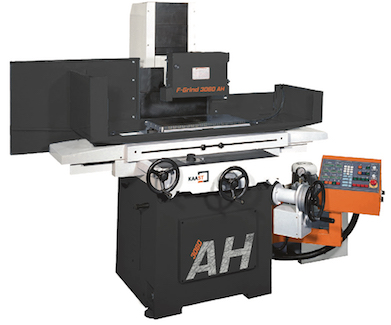michiganbuck
Diamond
- Joined
- Jun 28, 2012
- Location
- Mt Clemens, Michigan 48035
Ot:
Grinder long travel rate on modern surface grinder machines is about 200 to 900 Inches per minute.
Older and some new machines don't tell the IPM so a quick method to tell is:
Measure the travel length then count the seconds going from stop to stop as
one hippopotamus, two hippopotamus three...
So perhaps you might travel 12 inches in 3 seconds.
12" / 3 = 4" per second x 60 = 240 IPM, a slower but OK rate for a hard par, and depending on the depth of grind along with the cross-feed amount.
(300 to 500 is a common LTF, long travel feed).
With practice one can calculate this in their head...and adding a note to a part print can save re-engineering the grinding process every time that job comes up...and help an apprentice learn to approximate feed rates.
One might print note "LTF 300ipm 46H w"
With a too-fast long feed rate, one can actually slow the wheel RPM and lift the wheel head (the formula for burning/scrapping the part). an example is pushing a piece of steel into a bench grinder to the point of pushing the whole bench.
Counting one thousand, two one thousand is Ok ..but thousandths are for measuring stuff.
One old method to gauge/estimate long feed rate was to watch the spark as to the space between sparks
Grinder long travel rate on modern surface grinder machines is about 200 to 900 Inches per minute.
Older and some new machines don't tell the IPM so a quick method to tell is:
Measure the travel length then count the seconds going from stop to stop as
one hippopotamus, two hippopotamus three...
So perhaps you might travel 12 inches in 3 seconds.
12" / 3 = 4" per second x 60 = 240 IPM, a slower but OK rate for a hard par, and depending on the depth of grind along with the cross-feed amount.
(300 to 500 is a common LTF, long travel feed).
With practice one can calculate this in their head...and adding a note to a part print can save re-engineering the grinding process every time that job comes up...and help an apprentice learn to approximate feed rates.
One might print note "LTF 300ipm 46H w"
With a too-fast long feed rate, one can actually slow the wheel RPM and lift the wheel head (the formula for burning/scrapping the part). an example is pushing a piece of steel into a bench grinder to the point of pushing the whole bench.
Counting one thousand, two one thousand is Ok ..but thousandths are for measuring stuff.
One old method to gauge/estimate long feed rate was to watch the spark as to the space between sparks
Last edited:




